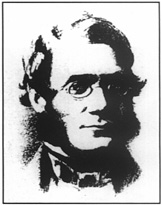
A Scottish physician, Thomas Boswell Watson, arrived in Macao in 1845, thirty years old and with the fervent intention of settling and practising medicine in this small territory. Besides becoming a doctor, a good friend, and an apprentice to Chinnery, Watson came to be recognized as a particularly gifted painter.
His watercolours and pen and pencil drawings are testimonials of Macanese buildings and sites long demolished or presently transformed beyond recognition. Particularly signficant are the views taken from the terrace of his house in the Praia Grande (Praya Grande) promenade, most probably dated from between 1850 and 1856, when the artist reached an existence of serene happiness, having overcome his financial insecurities, physical problems caused by fragile health and constant intellectual longings for his motherland.
Stylistically his drawings reveal such a strong influence of his master, George Chinnery, one could assume that their close friendship lasted unshakeable from Watson's arrival in Macao to Chinnery's death in 1852. Watson's works attest to a particular mood which goes well beyond being a formal borrowing from Chinnery's mastery, expressing a mature personality but never reaching the sublimity of his fellow citizen.
Despite leaving Macao for Hong Kong in 1856, he would later confess that the best and happiest years of his existence in the Orient had been spent in this Portuguese colony.
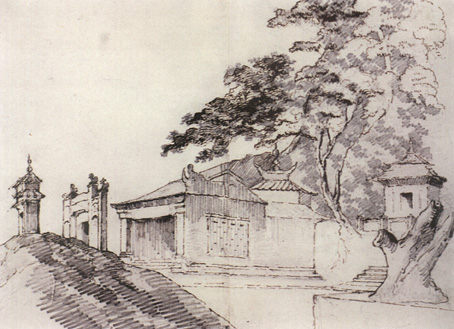 A-Ma Temple.
THOMAS WATSON (°1815-†1860).
Ca 1850. Pencil and sepia ink on paper. 20.1 cm x 27.2 cm.
Leal Senado / Luís de Camões Museum, Macao.
In: Macau•A invenção da paisageM, ill. 40.
A-Ma Temple.
THOMAS WATSON (°1815-†1860).
Ca 1850. Pencil and sepia ink on paper. 20.1 cm x 27.2 cm.
Leal Senado / Luís de Camões Museum, Macao.
In: Macau•A invenção da paisageM, ill. 40.
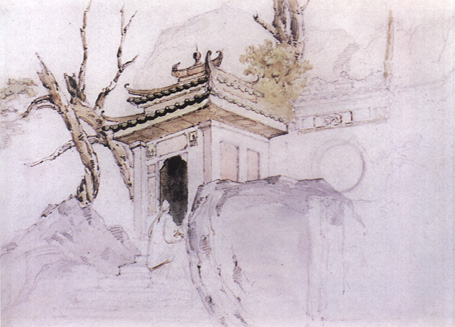 Pavillion at A-Ma Temple.
THOMAS WATSON (°1815-†1860).
Terminus a quo 1845-terminus ad quem 1856. Pencil, watercolour and sepia ink on blue paper. 24.3 cm x 34.1 cm.
Leal Senado / Luís de Camões Museum, Macao.
In: Macau•A invenção da paisageM, ill. 41.
Pavillion at A-Ma Temple.
THOMAS WATSON (°1815-†1860).
Terminus a quo 1845-terminus ad quem 1856. Pencil, watercolour and sepia ink on blue paper. 24.3 cm x 34.1 cm.
Leal Senado / Luís de Camões Museum, Macao.
In: Macau•A invenção da paisageM, ill. 41.
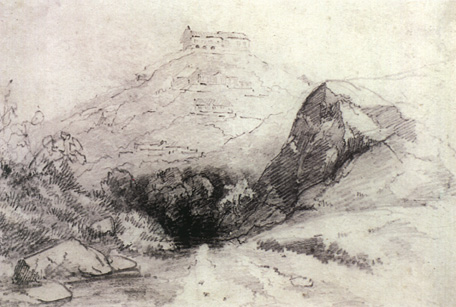 View of Penha Church.
THOMAS WATSON (°1815-†1860).
Ca1840. Pencil on paper. 13.4 cm x 19.4 cm.
Leal Senado / Luís de Camões Museum, Macao.
In: Macau•A invenção da paisageM, ill. 42.
View of Penha Church.
THOMAS WATSON (°1815-†1860).
Ca1840. Pencil on paper. 13.4 cm x 19.4 cm.
Leal Senado / Luís de Camões Museum, Macao.
In: Macau•A invenção da paisageM, ill. 42.
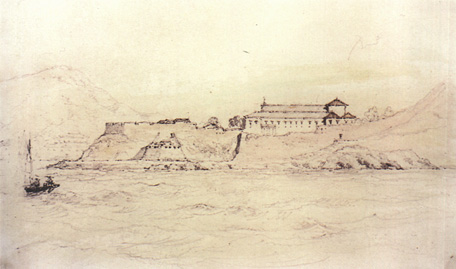
Convent and Fortress of St. Francis.
THOMAS WATSON (°1815-†1860).
Terminus a quo 1845-terminus ad quem 1856. Pencil and colour washes on paper. 14.5 cm x 25.0 cm.
Leal Senado / Luís de Camões Museum, Macao.
In: Macau• A invenção da paisageM, ill. 43.
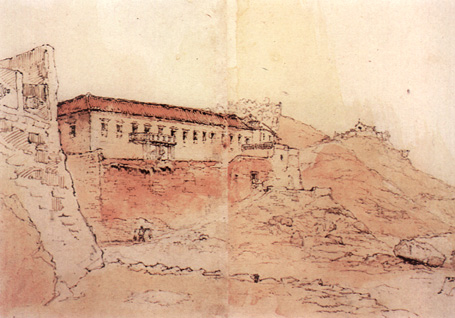
Franciscan Fort and Guia Fortress.
THOMAS WATSON (°1815-†1860).
Terminus a quo 1845-terminus ad quem 1856. Pencil and colour washes on paper. 19.8 cm x 27.7 cm.
Leal Senado / Luís de Camões Museum, Macao.
In: Macau•A invenção da paisageM, ill. 44.
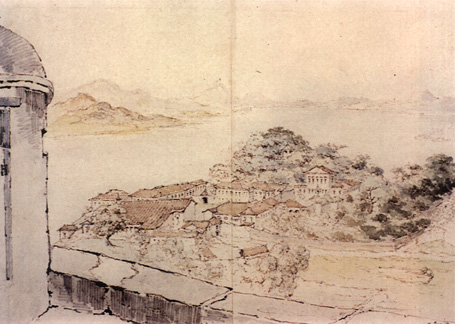
View of Macao from Monte Fortress [Mount Fort].
THOMAS WATSON (°1815-†1860).
1852. Pencil, watercolours and sepia ink on paper. 19.8 cm x 27.4 cm.
Leal Senado / Luís de Camões Museum, Macao.
In: Macau•A invenção da paisageM, ill. 45.
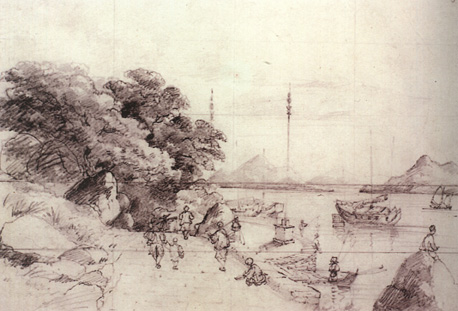
Entrance Way of A-Ma Temple.
THOMAS WATSON (°1815-†1860).
Terminus a quo 1845-terminus ad quem 1856. Pencil on paper. 18.6 cm x 26.6 cm.
Leal Senado / Luís de Camões Museum, Macao.
In: Macau•A invenção da paisageM, ill. 46.
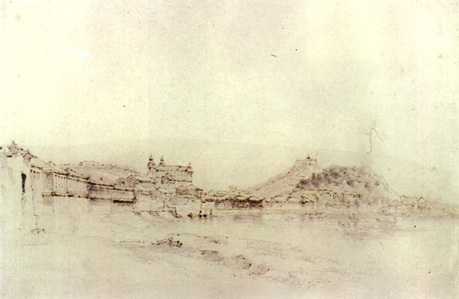
Inner Harbour.
THOMAS WATSON (°1815-†1860).
Terminus a quo 1845-terminus ad quem 1856. Pencil and sepia ink on paper. 18.0 cm x 30.0 cm.
Leal Senado / Luís de Camões Museum, Macao.
In: Macau•A invenção da paisageM, ill. 47.
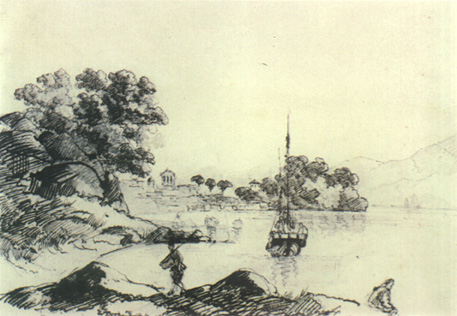
Praia Grande.
THOMAS WATSON (°1815-†1860).
Terminus a quo 1845-terminus ad quem 1856. Pencil and sepia ink on paper. 17.3 cm x 25.2 cm.
Leal Senado / Luís de Camões Museum, Macao.
In: Macau • A invenção da paisageM, ill. 48.
start p. 183
end p.